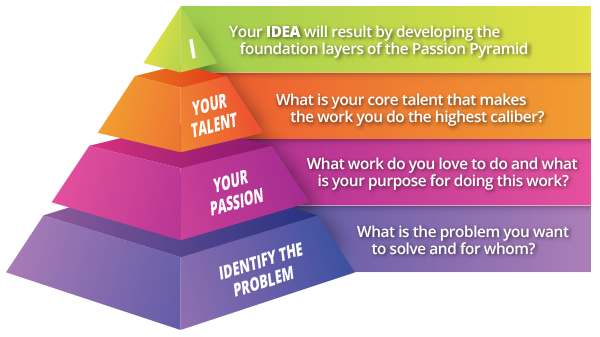
What’s your idea for a business?
Do you already have some ideas for a business? Or are you unsure of how you can earn income doing work you love? Well, here’s how we can start shaping your business idea (or refine an already-existing business idea).
Before we get into the Passion Pyramid formula, you will need to download what’s in your head and heart right now as it relates to the business you want to launch.
Grab your journal and do these simple prompts as in-depth as possible so you “drain the tank:”
What is your passion work as it exists right now? Whether you are earning income from it or not, write about what it is and why you love it so much you could do it 24/7/365.
What is the business idea(s) you already have been chewing on or have already started?
Tell the story of where and with whom have you already done this work for and what the experience was for you and who you served.
Write about any other aspects as it relates to building a business around work you love.
The best part is…
Whatever your passion is, it doesn’t have to be a life sentence. What you learn in this program with the passion that you are most lit up about right now can be compounded and repurposed to expand other passions!
Follow all passions for a truly rich life.
The Passion Pyramid
To help you refine your business idea, let’s use the Passion Pyramid. The process of working through the layers will help you identify your idea. Don’t be surprised if you have multiple ideas, as this type of brainstorming will surface a lot of different directions that you can then choose from.
Write these out on a piece of paper in three columns:
Column 1: What is the problem you want to solve and for whom?
Column 2: What work do you love to do and what is your purpose for doing this work?
Column 3: What is your core talent that makes the work you do the highest caliber?
Next, go back and keep adding to each column. You may find that your problem column starts out as a “want” versus the problem. That’s actually good as it can help you reverse engineer to get to the problem.
For example, let’s say your customer wants a closet that’s organized, easy to find things and fits everything they want to keep and use. That is more of a want versus a problem.
The problem is that they’re too busy working at their job or running their household to sort out their closet, they don’t know how to organize it the way they want, they are tired, worn out and stressed by their “messy closet.”
You are an incredible closet organizer and so the problem you solve is to help busy people have more time and less stress/embarrassment because they now have consistently organized closets that allow them to find what they want fast and effortlessly maintain because they know where everything is and where it all goes. They have greater appreciation for what they have, and are inspired to enhance their wardrobe and feel better about their appearance.
The goal is not to identify a gap in the marketplace as many believe. Because you’re deploying your unique talent in combination with your passion, you already have arrived at a Unique Selling Proposition (USP) because you and your process are the USP.
The Passion Pyramid exercise is the beginning steps of building your brand, your processes, your distinct service and/or product. Refer back to this work as you move through the course.

What’s your why?
The last step in this ideation segment is to really give heartfelt thought to why you are creating a business based on your passion. Your why will shape how your business unfolds and generate momentum when you remember why you’re doing work you love.
Answer this question:
Why?
Additional prompts: Why do you want to do work you’re passionate about? How will doing this work help others? How will doing this work create a better community? How will doing this work improve life for others around the world? How will doing this work inspire people hungry for something different; something better? How will doing this work impact YOU?
You can also think of your why in the context of three different “reaches” or “impacts” in the shape of three concentric circles.
The innermost circle can be how it will impact you, your happiness, your ability to grow and create and serve others
The next larger circle can be how it will impact those you serve, your family, your community at large
The largest circle can represent the world of people, or earth as a planet, or a condition such as peace, hunger or connection
Your why defines the cascading impact of you doing work you love has on everything and everyone—what you were meant to do.
